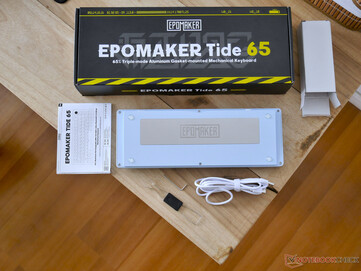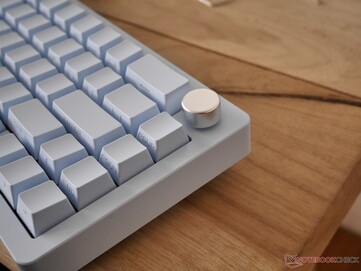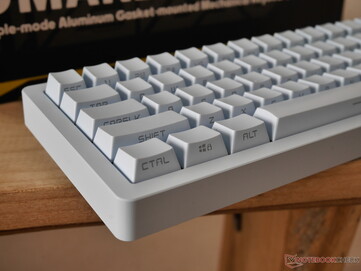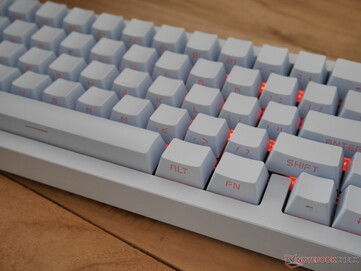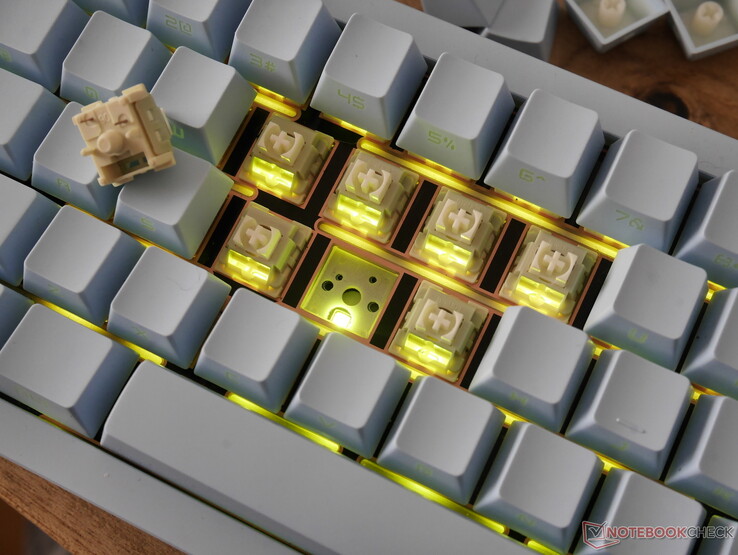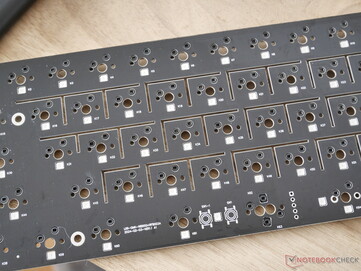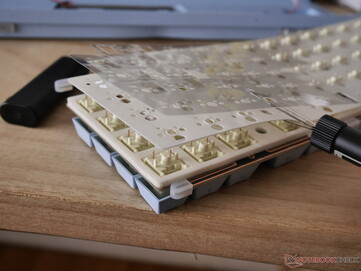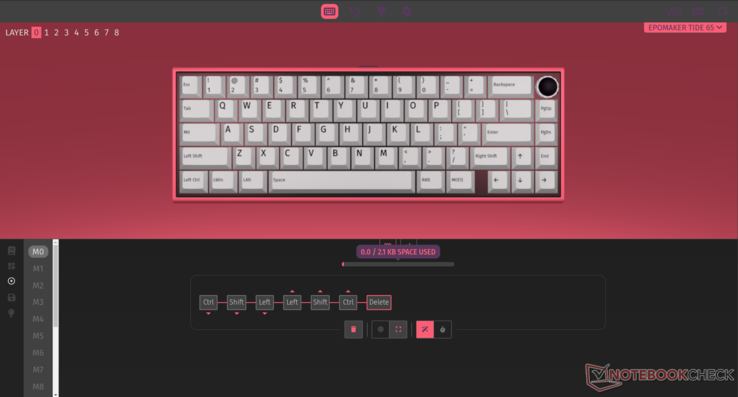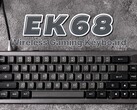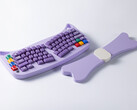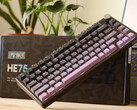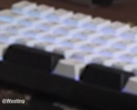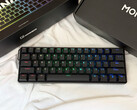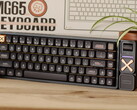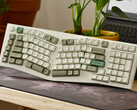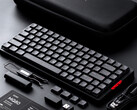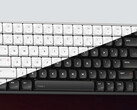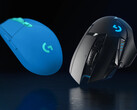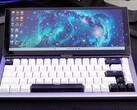Epomaker Tide65 wireless mechanical keyboard review: Solid budget gaming keyboard, mediocre typing experience
Subtle gaming looks on a budget.
The Epomaker Tide65 is more than just a shrunken-down version of the Tide75 we reviewed previously. The compact layout, fast wireless connectivity and lightweight short-travel gaming switches check a lot of boxes, especially considering the price. However, its gaming focus results in a compromised typing feel if you get the wrong configuration.Julian van der Merwe, 👁 Enrico Frahn Published 🇫🇷 🇪🇸 ...
Verdict - A gaming keyboard first with options for everyone else
The Epomaker Tide65 exhibits impressive build quality for the price, especially considering it is frequently discounted by as much as 50%. However, the focus on gaming features, short-travel switches and a rather stiff typing feel result in compromises in the typing experience, specifically a high-pitch sound profile and a stiff feel.
Fast 1,000 Hz polling over wired and 2.4 GHz connections, along with decent battery life even with the RGB enabled, make the Tide65 a solid choice for gamers who want something that looks cleaner and feels better than what's on offer from big gaming brands.
At the regular retail price, there are other mechanical keyboards with better keycaps and sound profiles. But the Tide65 regularly comes down to under $60, at which point it is almost unbeatable value. The Tide65 with Lemon switches makes for a solid, affordable mechanical gaming keyboard, but typists are better off with the Zebra switches we tried in the Tide75 before.
Pros
Cons
Price and availability
The Epomaker Tide65 is available from Amazon, with a starting price of $105.99. It's worth waiting for deals, which can drop the price to as low as $52.99. More expensive versions of the Tide65, like our review unit, cost up to $119.99 on both Amazon and the Epomaker online shop.
Table of Contents
- Verdict - A gaming keyboard first with options for everyone else
- Specifications
- Unboxing and accessories
- Case and build quality
- Keycaps
- Typing experience - 1.6 mm actuation distance asks for patience
- Epomaker Tide65 sound sample and comparison
- Wireless connectivity and battery life
- Disassembly and internals - different gasket mount, different typing feel
- Software customisation - great VIA implementation
- Conclusion
As the name suggests, the Epomaker Tide65 is a 65% mechanical keyboard. Unlike the Tide75 we reviewed before, the Tide65 definitely has more of a gaming focus. The Tide65 features a compact 65% US ANSI layout, lightweight Lemon linear switches, and a volume knob. The Tide65's QMK/VIA-compatible firmware mean that it is fully customisable and remappable, including the volume knob. Our review unit features double-shot PBT keycaps with a side-printed shine-through legend.
Specifications
| Form factor and size | Compact 65%, 320 × 114 , 21.5 mm front height |
| Case material | Anodised or e-coated CNC-cut aluminium |
| Weight | 1,274 g |
| Plate material and mounting style | FR4 plate, silicone sock gasket mount |
| Connectivity | 2.4 GHz, Bluetooth 5.0, USB type-C |
| PCB and switch style | Flex-cut PCB, compatible with 3- or 5-pin hot-swap mechanical switches |
| Default switch options | 40 gf Epomaker Lemon (in blue and purple colourways with side-printed legends), Epomaker Zebra |
| Layout | US ANSI |
| Keycap material and profile | Shine-through double-shot PBT, OEM profile (purple or blue only) or non-shine-through double-shot PBT in Cherry profile (black or blue only) |
| Customisation software | QMK/VIA support with .JSON file |
| Backlight | South-facing per-key RGB |
| Polling rate | 1,000 Hz over 2.4 GHz and USB-C, 125 Hz over Bluetooth |
| Price | $105.99–119.99, depending on the colourway and keycaps chosen |
| Availability | Amazon* or Epomaker store |
Unboxing and accessories
The Epomaker Tide65's unboxing experience is about what you'd expect from a keyboard in the $110 price range. The box is a regular printed cardboard affair, although it features some bright yellow chevrons and segment display-style numbers printed on it. The box design could be seen as polarising.
Alongside the keyboard, which is under a thin transparent plastic dust cover and wrapped in a plastic film, there is a small box containing the included accessories. The accessories consist of a small Allen key, a plain but thick white rubber USB type-A to type-C cable, and a keycap and switch puller combo tool. There are no extra switches or keycaps in the box. More concerningly, the lack of extra switches means that if any of the stock switches in the Tide65 fail, you will need to buy a whole new set of switches. Epomaker doesn't seem to sell the Lemon switches as a standalone product, but the Epomaker Zebra switches cost $19.99 for 100 switches on Amazon.
Case and build quality
Much like the Epomaker Tide75 we recently reviewed, the Tide65's build quality and finish are solid. The electrophoretic coating on our blue review unit is a step above the anodised black and gold finish we saw on the Tide75. Likely as a result of the thicker coating, the mild CNC chatter marks we saw on the chamfered edges of the Tide75 are absent in our Tide65. The finish across the board is actually flawless.
The bottom of the Tide65 features a shiny PVD weight with a large laser-engraved Epomaker logo laser-engraved. The build quality feels great, but the weight picks up fingerprints quickly and seems to be somewhat susceptible to scratches, since our review unit picked up some mild scratches during our roughly week-long review period. The Tide65's volume knob is also metal with a thin plastic insert where it attaches to the encoder stem. The knob is anodised, and there is a very slight roughness to the surface finish. It's rather visible than feelable, but that appears to be intentional and consistent.
Keycaps
There's a lot to like about the Epomaker Tide65's keycaps, but there are a few aspects that may deter some users. For one, the double-shot PBT means the keycaps shouldn't show any significant signs of wear anytime soon. The walls of the keycaps are thick, giving them a quality feel. Being shine-through is also a nice thought, since not many pre-built keyboards with south-facing LEDs and this sort of built quality come with shine-through keycaps. The RGB shine-through is also very bright and capable of illuminating the characters on the keycaps clearly and consistently.
The biggest complaints about the Tide65's keycaps come from the OEM profile, which makes the keyboard feel very high and can be uncomfortable to type on. Another minor gripe is that the keycaps don't seem to fit onto the switches particularly well. They never went flying off the keyboard in our testing, but they were noticeably loose.
If you bottom-out the key and then slide your finger off the edge of the keycap, the keycap starts to slide off the top of the switch. The tops of the Tide65's keycaps are very smooth and lack the texture we've seen on other Epomaker keyboards. While this may come down to personal preference, the smoothness of the keycaps was noticeably uncomfortable for typing, making the opaque keycap option we tested on the Tide75 a better option for general-purpose use.
Typing experience - 1.6 mm actuation distance asks for patience
Typing on the Epomaker Tide65 is decent, although somewhat different to the Tide75. The difference will be more obvious in the disassembly section of this review, but the internal differences mean that the Tide65 is stiffer and more responsive than the Tide75. While this stiffness is great for gaming, it can be fatiguing if you're used to a softer typing experience.
Epomaker's Lemon switches set the Tide65 apart from similar mechanical keyboards and are the main reason it can reasonably still be called a gaming keyboard, even as Hall-effect keyboards, like the Iqunix EZ63 and Wooting 80HE, are taking over the gaming scene. Epomaker says the Lemon switches have a 40 gf actuation force, but they feel far lighter than most other switches in the same ballpark. This suggests that the switches aren't very progressive, requiring similar bottom-out force and initial force.
The Lemon switches also have an actuation point of just 1.6 mm, which is anywhere from 0.4 mm to a full millimetre less than many traditional mechanical switches. The Lemon switches bottom out at only 3.5 mm, which is shorter than the 4 mm typical of many mechanical switches.
While these differences sound minor, they are quite noticeable in practice and will require getting used to. But they so make gaming on the Tide65 somewhat more comfortable, since you don't need to press the switch very far or hard to actuate it. Except for the C key, which felt somewhat notchy, the Lemon switches of our test unit were very smooth throughout the switch travel.
One major drawback to the compact 65% layout of the Tide65 is the lack of certain keys. A missing home key is odd, given the presence of an end key, but this can be expected from a compact layout that includes an arrow cluster. However, the lack of a delete key is a questionable decision that could have easily been addressed by including a few extra keycaps in the box.
When it comes to sound profiles, the Tide65 is high pitch and firmly in clacky territory, much more so than even the Tide75. This high-pitch bottom out sound can largely be attributed to the Lemon switches and their nylon blend top and bottom housings and POM stems in addition to the stiff PBT keycaps.
Swapping out the switches for a set of Epomaker Jade Blossom switches goes a long way to giving the Tide65 a deeper sound profile. While the sound profile of a keyboard is highly subjective, the stabilisers in the Tide65 are objectively poor and exhibit significant rattling on the space bar, enter and backspace keys. Additional lubrication and a band-aid mod should help reduce rattle.
The complaints that stem from the keycaps and lightweight switches can be resolved by simply opting for one of the colourways that include the Zebra switches and Cherry profile keycaps. That combination is much more comfortable for typing.
Below is a typing sound sample of the Epomaker Tide65 followed by a sample of the Tide75 for comparison.
Epomaker Tide65 sound sample and comparison
Wireless connectivity and battery life
The inclusion of Bluetooth, 2.4 GHz and wired connectivity makes the Tide65 quite versatile, although it's unlikely to see much use as a portable keyboard. The keyboard can be put into wireless mode using the switch on the back, but you need to use a combination of keys to switch between Bluetooth and 2.4 GHz modes. There is no dedicated wireless mode selector, like the one found on Keychron keyboards.
The Tide65 is powered by the same 4,000 mAh capacity battery as the Tide75. It has an advantage when the backlighting is enabled, because there are fewer LEDs consuming battery power.
The best-case scenario is with deactivated backlighting and connected via Bluetooth, in which the Tide65 performed identically to its larger counterpart. In this setup, we measured an estimated battery life of around 200 hours. Connecting via 2.4 GHz and cranking the RGB backlighting to full brightness reduced the calculated battery life estimate to around 55 hours, which is still reasonable.
Disassembly and internals - different gasket mount, different typing feel
Getting into the Epomaker Tide65 is simple, thanks to the exposed Allen-head screws and the included Allen key. Once the six screws holding the bottom and top cases together are removed, the cases come apart, revealing plenty of sound damping materials and a gasket mount that looks much neater than that of the Tide75's Poron gaskets.
The little silicone socks covering the tabs on the FR4 plate help isolate the plate and PCB from the case. While this helps reduce reverberation through the case, it most importantly softens the typing feel. Unlike the foam gaskets of the Tide75, these silicone gaskets are significantly stiffer, which limits flex and the amount of kinetic energy they can absorb. This makes for a snappier, more responsive typing feel, but can also feel harsh to anyone used to softer mounts.
The bottom case foam fills out the case, which further limits the amount of flex from the flex-cut FR4 plate and the thin PCB. Removing this foam results in a little more flex from the gasket and plate in exchange for more ping from the case, which could potentially be resolved with tape and force-break mods.
Software customisation - great VIA implementation
The Epomaker Tide65 supports customisation in the web app VIA. This gives the keyboard a lot of flexibility when it comes to remapping, macros and customisation on Windows, Linux, and macOS. The Tide65 offers a total of nine customisable layers in VIA, which is more than enough for basically anyone. It can also be used to toggle game- or program-specific layers. Similar is true for macros, with a total of 16 macro slots available for recording or programming macros. Advanced features, like ModTap and LayerTap, also worked well via the "Any" key mapping option.
Both key remapping and macros worked well, but buyers should be careful to download the JSON file from Epomaker's download site instead of from the Tide65 product page. The file on the Tide65 product page is not up-to-date and doesn't give users the option to select the correct layout or create macros. On the topic of split space bars, it's a shame Epomaker doesn't offer a split spaces kit for the Tide65, since split space bars can be valuable and improve usability and even ergonomics.
Conclusion
The Epomaker Tide65 offers impressive build quality for the price, and can frequently be found for as little $55 on Amazon. Pricing makes the Tide65 a killer deal, given how many boxes it checks. However, prospective buyers should be aware that the typing feel and sound have been compromised to improve the responsiveness, at least in the case of the Lemon switches and shine-through keycaps. That said, extensive options exist to modify the Tide65, including different keycaps and switches available at checkout. It's a worthy option for anyone looking for a solid entry-level mechanical keyboard.
Transparency
The selection of devices to be reviewed is made by our editorial team. The test sample was given to the author by the manufacturer free of charge for the purposes of review. There was no third-party influence on this review, nor did the manufacturer receive a copy of this review before publication. There was no obligation to publish this review. As an independent media company, Notebookcheck is not subjected to the authority of manufacturers, retailers or publishers.





